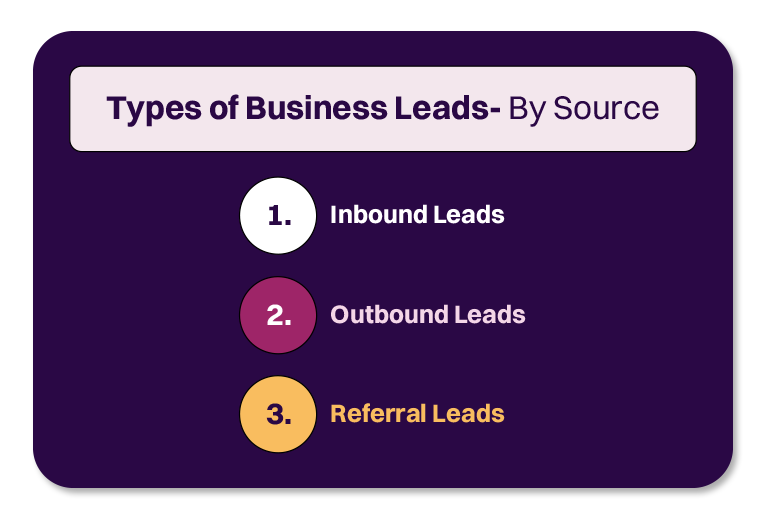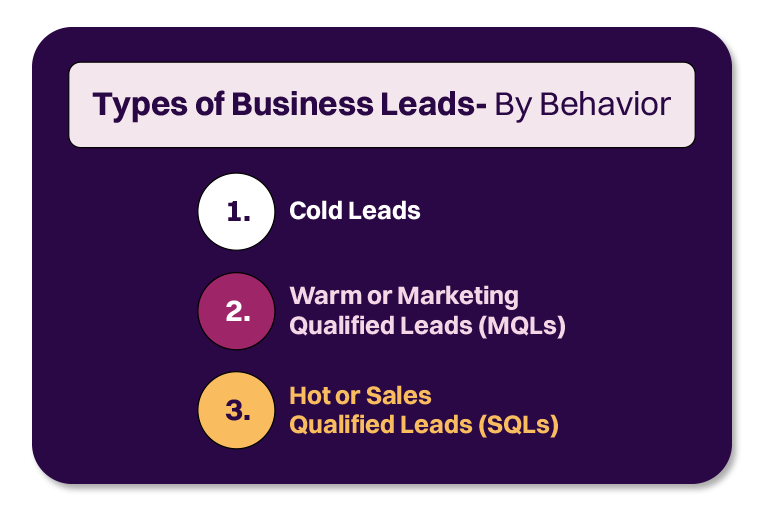
What Exactly Are Business Leads And Their Significance?
Have you ever wondered why they say, "Leads are the lifeblood of a business?" Well, we did, too, until we dove into understanding business leads!
Simply put, your business lead is a potential customer seeking your products or services. Or, they can benefit from your offering.
Additionally, companies with effective lead-generation strategies are 133% more likely to outperform their competitors. That's right; it makes it even more important for you to learn about business leads.
So, let us share our knowledge on the topic with you. As we know which people we call business leads, let’s learn different types.
Types of Business Leads- By Source

When it comes to business leads, they can spring from various sources, like a surprise party! Each source defines how you can approach different leads.
So, let's see the different lead sources you can leverage.
1. Inbound Leads
Inbound leads are potential customers who come to your business naturally, showing interest in your products or services. These leads are often highly valuable for your business because they actively seek information or solutions you already offer.
Sources to Attract Inbound Leads
- Content Marketing:
This involves creating and sharing valuable, relevant content through:
- Videos
- Infographics
- Ebooks, and more.
- SEO (Search Engine Optimization):
It is optimizing your website and content to rank higher in search engine results using:
- Keyword research
- On-page optimization
- High-quality content creation
When your website appears in relevant search queries, it can generate organic traffic and leads.
- Social Media Marketing:
Social media platforms are powerful tools for generating inbound leads. You can attract potential customers by sharing valuable content on social platforms.
You can engage with your audience in real time, addressing their concerns right away. In fact, your quick response to leads, especially within the first hour, ensures a 7X higher chance of meaningful conversations with decision-makers.
Plus, you can run targeted social media ads in front of interested leads.
2. Outbound Leads
You can generate outbound leads through proactive outreach efforts. While they may be less warm than inbound leads, they can still be highly valuable if you approach them strategically.
Sources to Attract Outbound Leads
- Cold Email Marketing:
It requires you to generate interest in potential prospects unaware of your brand. As we already mentioned earlier, you need to craft personalized and relevant email campaigns to capture the attention of potential leads.
In fact, 93% of your cold emails often get opened within the first 4 hours. So, you must craft your emails really well.
- Cold Email Marketing Tips:
- Add the recipient’s name or business name or their major pain point in the subject line.
- Show empathy, suggest solutions, and share valuable resources.
- Use A/B testing to refine your email subject lines and content to improve open and response rates.
- Cold Calling:
In cold calling, you make phone calls to potential customers to educate them about your product/service. But, these potential customers are the ones who have no earlier interaction with your brand. While it can be challenging, a well-scripted and empathetic approach can turn cold calls into warm leads.
- Cold Calling Tips:
- Develop a script focusing on the benefits your product or service can provide the prospect.
- Address their pain points.
- Train your sales development reps (SDRs) to listen actively to your potential clients. It’ll help them negotiate better.
- Networking and Events:
Another way to reach your outbound leads is by attending industry events, conferences, and networking functions. These events allow you to connect with your potential leads in person. Building relationships at such events can lead to valuable business connections and potential customers.
- Networking And Events Tips:
- Stay updated on upcoming relevant events.
- Try to join as a speaker to give valuable insights to your target audience.
- Prepare presentations for panel members.
- After networking events, follow up with personalized emails or LinkedIn messages to nurture those connections.
3. Referral Leads
Your referral leads come from existing customers or business partners who recommend your products or services to others. It’s enticing that 92% of customers trust referrals from people they know.
These leads are often highly qualified and have a higher conversion rate. You can get your referral leads in two ways:
- Leveraging Customer Referrals
Encourage your satisfied customers to refer others to your business. Implement referral programs or offer incentives to motivate customers to spread the word.
- Partner Referrals
Form partnerships with other businesses in complementary industries. When your partners refer clients or customers to you, it can lead to mutually beneficial relationships and a steady stream of referrals.
- Referral Tips:
- Establish clear referral agreements with your partners to ensure a smooth and fair referral process.
- Create a referral portal on your website where customers can easily refer friends and colleagues.
- Try A/B testing on the best incentive offer to get referral leads.
Types of Business Leads- By Behavior

Your business leads may show different behaviors toward your brand. Some may show more interest than others. Knowing the differences gives you a foundation for approaching each of them effectively.
For your help, we listed 3 main types of business leads by behaviors and which approaches work on them.
1. Cold Leads
These are prospects with no prior interest in your product or service. In fact, they might not even have heard of your brand. Thus, they typically are at the initial stage of your sales funnel. You’ll need to put your brand before them via strategic marketing efforts.
Nurturing Strategies for Cold Leads
- Perform personalized cold email outreach where you can share valuable resources with them.
- You can cold call them to reach them one-on-one and introduce your brand in detail. Check out the cold-calling script to get an idea.
2. Warm or Marketing Qualified Leads (MQLs)
MQLs are your business leads who show active interest and engagement with your marketing efforts. But they may not be sales-ready yet. Hence, you must further educate them about your offerings.
Plus, you should track their interactions to find out when they are ready. Again, you must nurture them to push them forward in your sales funnel.
Nurturing Strategies for MQLs
- They often require nurturing through targeted communication via emails, calls, SMS, and connection forms.
- You can win them with customized solutions as per their business needs.
- Demonstrate the value of your offer to move them closer to conversion.
3. Hot or Sales Qualified Leads (SQLs)
SQLs are prospects who have shown high interest in your offerings. That’s why they are called “Hot” leads. Also, they are more critical than your warm leads as they are highly likely to convert into paying customers.
Nurturing Strategies for SQLs
- You need to encourage direct sales engagement via personalized sales pitches.
- Address their specific pain points and objections and guide them toward making a purchase decision.
How to Qualify and Prioritize Business Leads?
34% of your fellow competitors find lead qualification as their main challenge. That’s because they fail to understand that not all leads are the same!
Some are like diamonds, ready to shine brightly, while others may need a bit more polishing. That's where lead qualification methods come into play. These are:
- Lead scoring
- Lead prioritization
Let’s see how you can use them:
1. Lead Scoring
Follow the given steps:
Apply Lead Scoring
This method lets you assign numerical values to your leads based on their characteristics and behaviors. Here’s the list of elements you can use to define your lead-scoring criteria:
- Demographics: Consider factors such as company size, industry, and job title to determine if a lead fits your ideal customer profile.
- Engagement: Track how leads interact with your content, emails, and website. Engagement can include email opens, click-through rates, and website visits.
- Behavior: Assess specific actions leads take, such as downloading a whitepaper, requesting a demo, or attending a webinar.
- Timing: Determine where leads are in the buying cycle. Leads showing immediate interest may receive a higher score.
Implement a Lead Scoring Model
Once you've defined your criteria, create a lead scoring model that assigns point values to each criterion.
For example, a lead's job title might be worth 10 points, while attending a webinar could be worth 20 points. You can do it manually or through automation using customer relationship management (CRM) software such as HubSpot.
Here is a sample of the lead scoring model:
| Lead Attribute | Points |
| Job Title | 10 |
| Company Size | 5 |
| Industry | 20 |
| Geographic Region | 20 |
| Website Activity | 30 |
Adjust Scoring Over Time
Regularly review and refine your lead scoring criteria to ensure they remain aligned with your business goals and evolving customer behavior. Analyze the effectiveness of your scoring model by comparing scores to actual conversion rates. Make adjustments as needed to improve accuracy.
2. Lead Prioritization
Lead prioritization is like sorting a deck of cards; you want to find your aces first. It's the art of ranking potential customers based on their buying readiness. It ensures you focus on the hottest prospects and close deals efficiently.
You can use the following tips:
Use a Suitable Lead Qualification/prioratization Framework
You can choose the most fitting lead qualification framework as per your resources and business needs among:
- BANT
- MEDDIC
- GPCTBA/C&I
- CHAMP
Let’s see what these frameworks consist of in brief:
BANT (Budget, Authority, Need, and Timing)
- Budget: Determine if the lead has the financial resources to make a purchase.
- Authority: Identify the decision-maker or the person with authority to make buying decisions.
- Need: Assess whether the lead has a genuine need for the product or service.
- Timing: Understand the timeline when the lead may make the purchase decision.
MEDDIC (Metrics, Economic Buyer, Decision Criteria, Decision Process, Identify Pain, and Champion)
- Metrics: Quantify the potential value and impact of your solution for the lead.
- Economic Buyer: Identify the person with the authority to create the budget for the company.
- Decision Criteria: Determine the criteria the lead will use to evaluate your offering (technical and financial).
- Decision Process: Understand the steps and timeline of the lead's decision-making process.
- Identify Pain: Identify the specific challenges or pain points the lead is experiencing.
- Champion: Find an internal advocate or champion within the lead's organization who supports your solution.
GPCTBA/C&I (Goals, Plans, Challenges, Timeline, Budget, Authority, Negative Consequences, and Positive Implications)
- Goals: Understand the lead's objectives and what they aim to achieve.
- Plans: Determine their strategies or plans to reach their goals.
- Challenges: Identify obstacles or difficulties they are facing.
- Timeline: Know when they intend to take action.
- Budget: Confirm they have the financial resources to proceed.
- Authority: Identify whether your prospects are key decision-makers.
- Consequences & Implications: Talk about the effects of the outcomes of choosing your solution on your prospects. Also, confirm what their future plans are after meeting the goals.
CHAMP (Challenges, Authority, Money, and Prioritization)
- Challenges: Understand the lead's pain points and challenges.
- Authority: Determine who has the decision-making power within the organization.
- Money: Assess the budget available for the purchase.
- Prioritization: Determine where implementing your solution falls in the lead's list of priorities.
Here’s the most detailed post about lead qualification frameworks.
Use Technology for Prioritization
Utilize CRM software or marketing automation tools to automate lead prioritization. These systems can calculate lead scores and provide real-time insights into lead behavior and interactions.
Some systems can even trigger automated actions based on lead prioritization, such as sending personalized emails or assigning leads to specific sales reps.
The best CRM tools you can use are Salesforce, HubSpot, and Mailchimp.
Create a Lead Prioritization Process
Establish a clear lead prioritization process to ensure consistency and alignment within your sales and marketing teams:
- Lead Assignment: Define who is responsible for following up with leads based on their prioritization.
- Lead Nurturing: For leads with lower priority scores, implement lead nurturing campaigns to keep them engaged until they become more sales-ready.
- Regular Review: Periodically review and adjust your lead scoring and prioritization processes to adapt to changing market dynamics and customer behavior.
- Communication: Foster strong communication between your marketing and sales teams to ensure seamless lead handoffs and follow-ups.
Conclusion
Well, our fellow lead enthusiasts, we hope you've enjoyed this journey of learning about business leads! Remember, leads are the fuel that powers your business engine, and how you manage them can make all the difference.
Speaking of making a difference, if you're looking for a top-notch partner in your lead generation endeavors, let me introduce you to Revnew. Our innovative strategies and dedication to delivering high-quality leads can catapult your business to new heights. So, why not give us a shot? Your future success may just be a click away!




